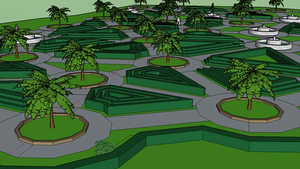Information
- Publication Type: Master Thesis
- Workgroup(s)/Project(s):
- Date: May 2018
- Date (Start): 2016
- Date (End): 16. July 2018
- TU Wien Library:
- Diploma Examination: 16. July 2018
- Open Access: yes
- First Supervisor:
- Keywords: procedural modeling, park layouts
Abstract
Procedural Modelling in Computer Graphics automates content generation, where commonly
manual methods have been employed, as in using modelling applications like Maya.
Grammar-based methods allow to describe creation of objects at a higher level, encoding
design decisions in rule files and enabling generation of infinite variations by just altering
the parameters. Methods for the synthesis of landscapes, street networks, buildings,
and vegetation have been described. In the context of the city generation, CityEngine
combines some such techniques into a commercial solution that can be used to generate
the whole city at once.
In the context of park synthesis, the process is divided into layout generation and placement
of objects in it. Typically, a park layout is either created manually and inserted into
the reserved area, or a shape grammar designed for building synthesis is employed. In the
first case, a change to the design or the surrounding regions could result in considerable
modifications required of the user. At the present moment, generation of parks and green
spaces in a city is rather limited and mainly focused on vegetation placement.
The aim of our work was to design a method for park layout synthesis, which when
combined with basic placement methods could be used to create believable park models.
Based on the observation of real-life parks and 3D models of parks, we have derived a
number of patterns, which have been translated into the rules of our novel shape grammar.
In particular, we introduce a rule for creating curved regions, which, to our knowledge,
has not been addressed yet at this level in grammar-based methods. We also introduce a
novel way to index arbitrary subset of the boundary and provide an additional insetting
operation based on that. In our work we have considered the context of CityEngine as a
possible use case.
Additional Files and Images
Additional images and videos
Additional files
Weblinks
No further information available.
BibTeX
@mastersthesis{VASILJEVS-2018-PMPL,
title = "Procedural Modelling of Park Layouts",
author = "Michael Vasiljevs",
year = "2018",
abstract = "Procedural Modelling in Computer Graphics automates content
generation, where commonly manual methods have been
employed, as in using modelling applications like Maya.
Grammar-based methods allow to describe creation of objects
at a higher level, encoding design decisions in rule files
and enabling generation of infinite variations by just
altering the parameters. Methods for the synthesis of
landscapes, street networks, buildings, and vegetation have
been described. In the context of the city generation,
CityEngine combines some such techniques into a commercial
solution that can be used to generate the whole city at
once. In the context of park synthesis, the process is
divided into layout generation and placement of objects in
it. Typically, a park layout is either created manually and
inserted into the reserved area, or a shape grammar designed
for building synthesis is employed. In the first case, a
change to the design or the surrounding regions could result
in considerable modifications required of the user. At the
present moment, generation of parks and green spaces in a
city is rather limited and mainly focused on vegetation
placement. The aim of our work was to design a method for
park layout synthesis, which when combined with basic
placement methods could be used to create believable park
models. Based on the observation of real-life parks and 3D
models of parks, we have derived a number of patterns, which
have been translated into the rules of our novel shape
grammar. In particular, we introduce a rule for creating
curved regions, which, to our knowledge, has not been
addressed yet at this level in grammar-based methods. We
also introduce a novel way to index arbitrary subset of the
boundary and provide an additional insetting operation based
on that. In our work we have considered the context of
CityEngine as a possible use case.",
month = may,
address = "Favoritenstrasse 9-11/E193-02, A-1040 Vienna, Austria",
school = "Institute of Computer Graphics and Algorithms, Vienna
University of Technology ",
keywords = "procedural modeling, park layouts",
URL = "https://www.cg.tuwien.ac.at/research/publications/2018/VASILJEVS-2018-PMPL/",
}

 poster
poster thesis
thesis


